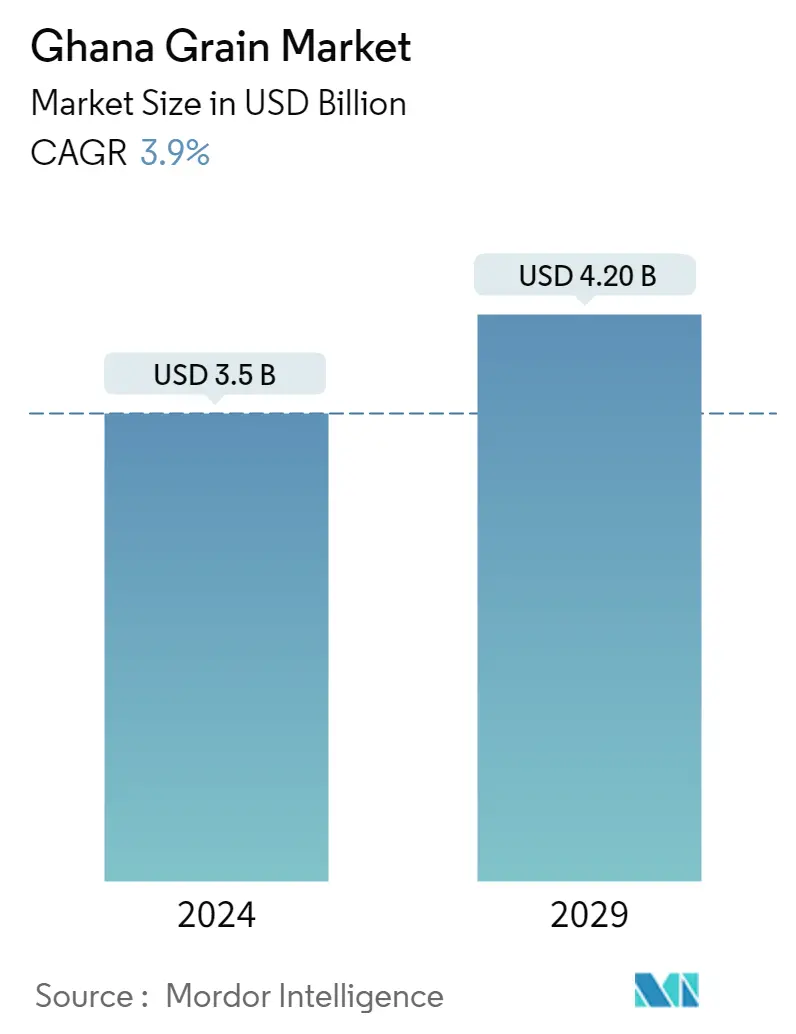Market Size of Ghana Grain Industry

| Study Period | 2019 - 2029 |
| Base Year For Estimation | 2023 |
| Forecast Data Period | 2024 - 2029 |
| Market Size (2024) | USD 3.50 Billion |
| Market Size (2029) | USD 4.20 Billion |
| CAGR (2024 - 2029) | 3.90 % |
Major Players*Disclaimer: Major Players sorted in no particular order |
Need a report that reflects how COVID-19 has impacted this market and its growth?
Ghana Grains Market Analysis
The Ghana Grain Market size is estimated at USD 3.5 billion in 2024, and is expected to reach USD 4.20 billion by 2029, growing at a CAGR of 3.9% during the forecast period (2024-2029).
- The Ghanaian grain market caters mainly to domestic demand. The grain market includes cereals, pulses, and oilseeds. Ghana is not a self-sufficient country in the cereal market, and various kinds of cereals are imported from other countries to satisfy domestic needs. In Ghana, cereals, such as maize and rice, are consumed significantly as these commodities are produced locally in significant volumes, and therefore are the major ingredients in traditional Ghanaian cuisine. For instance, Kenkey is a staple dish prepared with corn dough in the country. Kenkey is a popular dish among the Ghanaian population, which is usually served with pepper sauce and fried fish. Likewise, Rice remains a popular and rising part of the Ghanaian diet, owing to its convenience and changing palates.
- According to FAO, maize is the most widely cultivated cereal, with a production of 3.1 million metric ton in 2020. Rice and sorghum are the most cultivated crops in Ghana, after maize, with production totaling 973 thousand million metric ton and 356.0 thousand metric ton, respectively. Beans and peas are the most widely cultivated pulses, while groundnut is the most cultivated oilseed. As the trend suggests, the grain market in Ghana is expected to witness slow but steady growth over the forecast period.
- Furthermore, the growth of the middle-class population which is moving away from consuming traditional starches, like cassava and yam towards rice and maize-based convenience foods signifies a burgeoning market for Ghana grain producers. However, the threat of climate change, lack of efficient financial support, and extension activities to the small-scale farmers of Ghana, are expected to restrain the grain market during the forecast period.
Ghana Grains Industry Segmentation
Grain is the harvested seed of grasses, such as wheat, oats, rice, and corn. Other important grains include rye, millet, barley, and sorghum.
The Ghana Grain Market Report Includes Production Analysis (Volume), Consumption Analysis (Value and Volume), Export Analysis (Value and Volume), Import Analysis (Value and Volume), and Price Trend Analysis. The Market is Segmented by Crop Type (Maize, Millet, Sorghum, and Rice). The report offers market size and forecast based on value (USD million) and volume (metric ton) for the above segments.
| By Crop type (Production Analysis by Volume, Consumption Analysis by Volume and Value, Import Analysis by Volume and Value, Export Analysis by Volume and Value, and Price Trend Analysis) | |
| Maize | |
| Millet | |
| Sorghum | |
| Rice |
Ghana Grain Market Size Summary
The Ghanaian grain market is primarily driven by domestic demand, encompassing cereals, pulses, and oilseeds. Despite significant local production, Ghana relies on imports to meet its cereal needs, with maize and rice being the most consumed due to their integral role in traditional cuisine. The market is characterized by a shift in consumer preferences, with a growing middle class favoring rice and maize-based convenience foods over traditional starches. This trend presents opportunities for local grain producers, although challenges such as climate change and insufficient support for small-scale farmers pose potential constraints. Government initiatives like the Planting for Food and Jobs Programme aim to enhance domestic production and reduce reliance on imports, contributing to gradual market growth.
Maize stands out as the most crucial cereal crop in Ghana, both in terms of consumption and production volume. It serves as a staple food and is vital for poultry feed and the brewing industry. The government has implemented structural changes and partnerships to boost grain production, evidenced by increased fertilizer usage and improved seed distribution. These efforts are expected to enhance productivity and food security, reducing the need for imports. Additionally, initiatives like the 'One District, One Factory' program and the Mastercard Foundation's 'Grains for Growth' project aim to strengthen the grain supply chain, creating job opportunities and supporting economic development in the sector.
Ghana Grain Market Size - Table of Contents
-
1. MARKET DYNAMICS
-
1.1 Market Overview
-
1.2 Market Drivers
-
1.3 Market Restraints
-
-
2. MARKET SEGMENTATION
-
2.1 By Crop type (Production Analysis by Volume, Consumption Analysis by Volume and Value, Import Analysis by Volume and Value, Export Analysis by Volume and Value, and Price Trend Analysis)
-
2.1.1 Maize
-
2.1.2 Millet
-
2.1.3 Sorghum
-
2.1.4 Rice
-
-
Ghana Grain Market Size FAQs
How big is the Ghana Grain Market?
The Ghana Grain Market size is expected to reach USD 3.50 billion in 2024 and grow at a CAGR of 3.9% to reach USD 4.20 billion by 2029.
What is the current Ghana Grain Market size?
In 2024, the Ghana Grain Market size is expected to reach USD 3.50 billion.

